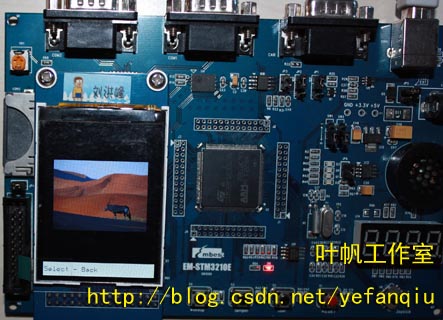【玩转.Net MF – 06】为Cortex-M3打造轻量级TinyGUI(上)
Microsoft .Net Micro Framework 官方UI库为WPF,针对320*240的LCD而言,至少额外需要150K以上RAM才能基本运行。而市面上常见Cortex-M3开发板的RAM大多为128K,少数开发板即使具备512k的RAM,运行官方自带的示例SimpleWPFApplication,也会出现内存溢出问题。此外由于Cortex-M3内核CPU主频大都在72M左右,官方图形库运行速度较慢。
一、参数指标
|
名称 |
代码大小 |
内存需求 |
运行性能 |
|
WPF |
120k(含Microsoft.SPOT.TinyCore.pe) |
>150k |
运行基准测试程序,TinyGUI运行速度大概是WPF的3~5倍 |
|
TinyGUI |
<2k |
无需求 |
注:TinyGUI采用类似DirectDraw技术,直接操作显存,所以无内存需求,且运行速度快

二、位图显示技术比较
WPF支持标准BMP,JPG,GIF图片显示,从使用角度来看非常方便,但是由于嵌入式LCD大都为16bit显示(RGB565格式),无论是BMP还是JPG和GIF都需要进行颜色转换,此外后者还需要进行格式转换处理。以上操作,不仅导致运行速度慢,还需要一定的内存进行图形缓存。
TinyGUI的位图显示采用转换后的tinyBMP位图格式,其格式和LCD显存格式保持一致,由于图形转换工作通过程序(如下)预先完成,所以在嵌入式系统上直接向显存拷贝即可完成位图显示,所以运行速度极快。

(注:其实Net Micro Framework的字体就是采用类似技术,官方提供转换程序和tinyFont字体库)
核心代码其实很简单,就是把32位位图转换为指定RGB(或BGR)格式的16位位图。
byte[] bytBuff = new byte[picBar.Height * picBar.Width * 2 + 12];
BinaryWriter bw = new BinaryWriter(new MemoryStream(bytBuff));
bw.Write(new byte[] { 84, 105, 110, 121, 66, 77, 80, 0 }); //TinyBMP\0;
bw.Write((UInt16)picBar.Width);
bw.Write((UInt16)picBar.Height);
Bitmap bmp = new Bitmap(picBar.Image, picBar.Width, picBar.Height);
for (int y = 0; y < bmp.Height; y++)
{
tspBar.Value = y;
for (int x = 0; x < bmp.Width; x++)
{
bw.Write(Color_32_16(bmp.GetPixel(x, y)));
}
}
三、TinyGUI图库接口
namespace System.TinyGUI
{
public sealed class Graphics
{
public Graphics();
public static void Clear(uint color);
public static void DrawEllipse(int x, int y, int width, int height, uint color);
public static void DrawImage(int x, int y, byte[] bytData);
public static void DrawImageEx(int x, int y, byte[] bytData, uint MaskColor);
public static void DrawLine(int x1, int y1, int x2, int y2, uint color);
public static void DrawRectangle(int x, int y, int width, int height, uint color);
public static void DrawString(int x, int y, string s, uint color);
public static void FillEllipse(int x, int y, int width, int height, uint color);
public static void FillRectangle(int x, int y, int width, int height, uint color);
public static uint GetPixel(int x, int y);
public static void Print(string str);
public static void SetPixel(int x, int y, uint color);
}
}
四、TinyGUI测试程序
运行效果图如下:


部分测试代码如下:
static void DrawGraphics()
{
x = rnd.Next(239);
width = rnd.Next(240 - x);
y = rnd.Next(319);
height = rnd.Next(320 - y);
c = rnd.Next(colors.Length - 1);
switch (index++ % 3)
{
case 0:
if (rnd.Next(10) > 5)
Graphics.DrawRectangle(x, y, width, height, colors[c]);
else
Graphics.FillRectangle(x, y, width, height, colors[c]);
break;
case 1:
if (rnd.Next(10) > 5)
Graphics.DrawEllipse(x, y, width, height, colors[c]);
else
Graphics.FillEllipse(x, y, width, height, colors[c]);
break;
case 2:
Graphics.DrawLine(x, y, rnd.Next(239), rnd.Next(319), colors[c]);
break;
}
Graphics.FillRectangle(0, 300, 240, 20, Color.White);
#if STM3210E_EVAL
Graphics.DrawString(2, 303, "Key - Back", Color.Black);
#else
Graphics.DrawString(2, 303, "Select - Back", Color.Black);
#endif
}
static void DrawPicture()
{
if (++picIndex > 12) picIndex = 0;
AccessFlash.Read((uint)(0x002A0000 + picIndex * 0xEA6C), 0xEA6C, picData);
if(StateIndex!= SystemState.Main) Graphics.DrawImage(20, 70, picData);
}
其中图片从Flash中进行读取,图片的下载方法可以参考我以前的博客文章《Flash远程读写》,为了在C#代码中读取Flash上的内容,我重新封装了一个AccessFlash类,可以直接读写Flash任意区域的数据,这部分内容我在后续文章中再进行介绍。
这篇文章仅仅介绍了TinyGUI应用层面的内容,下篇文章《为Cortex-M3打造轻量级TinyGUI(下)》将介绍TinyGUI是如何开发的,敬请关注。




【推荐】国内首个AI IDE,深度理解中文开发场景,立即下载体验Trae
【推荐】编程新体验,更懂你的AI,立即体验豆包MarsCode编程助手
【推荐】抖音旗下AI助手豆包,你的智能百科全书,全免费不限次数
【推荐】轻量又高性能的 SSH 工具 IShell:AI 加持,快人一步
· go语言实现终端里的倒计时
· 如何编写易于单元测试的代码
· 10年+ .NET Coder 心语,封装的思维:从隐藏、稳定开始理解其本质意义
· .NET Core 中如何实现缓存的预热?
· 从 HTTP 原因短语缺失研究 HTTP/2 和 HTTP/3 的设计差异
· 周边上新:园子的第一款马克杯温暖上架
· Open-Sora 2.0 重磅开源!
· 分享 3 个 .NET 开源的文件压缩处理库,助力快速实现文件压缩解压功能!
· Ollama——大语言模型本地部署的极速利器
· DeepSeek如何颠覆传统软件测试?测试工程师会被淘汰吗?